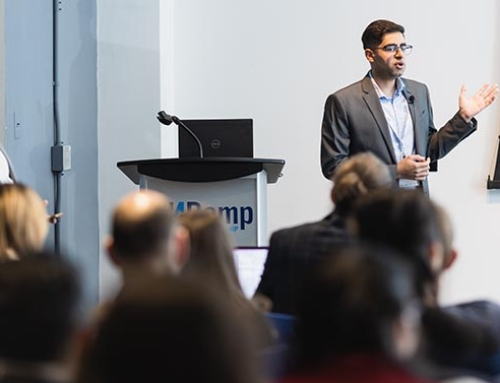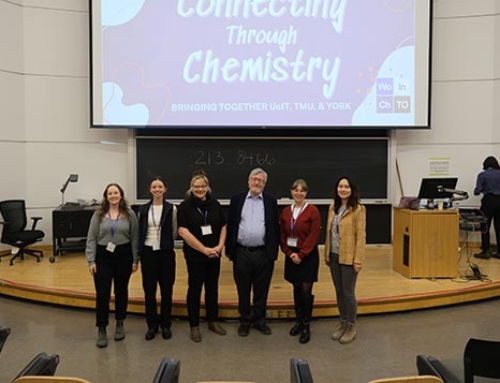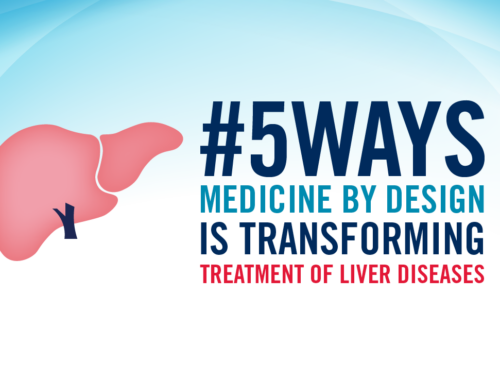
Medicine by Design’s 8th annual symposium featured an announcement about a new strategic alliance between Medicine by Design and CCRM (left; from left to right: Michael Sefton, Leah Cowen, Allison Brown, Michael May) and moved into a panel discussion about the role of partnerships in translating academic innovations to impact (right; left to right: Michael May, Derrick Rossi, Fiona Watt, Helen Blau, Peter Zandstra).
In academia, how do partnerships drive innovation, particularly in regenerative medicine?
Four panelists, Derrick Rossi, Fiona Watt, Helen Blau and Peter Zandstra tackled this central question at the Medicine by Design symposium, which took place on Dec. 6. The panel was moderated by Michael May, president and CEO at CCRM, a leader in developing and commercializing regenerative medicine -based technologies and cell and gene therapies.
The symposium — themed “Intentional Innovation” — attracted more than 750 registrants. Michael Sefton, scientific director of Medicine by Design and University Professor, Department of Chemical Engineering and Applied Chemistry and Institute of Biomedical Engineering at the University of Toronto (U of T), made a connection between the symposium theme and the panel’s discussion topic in his opening remarks.
“A premise of intentional innovation is that functional partnerships are required to translate research discoveries and ideas into innovations and to layer research in both public and private sectors to achieve impact,” he said.
Regenerative medicine uses stem cells and other living therapies to develop treatments for disease. It can also mean triggering stem cells that are already present in the human body to repair damaged tissues or to modulate immune responses.
While regenerative medicine research holds a lot of potential to be translated into some of the most powerful disease treatments ever developed, it is also a lengthy process, has a complex regulatory pathway and is expensive.
View the Medicine by Design 8th Annual Symposium photo gallery here.
Panel dissects the role of partnerships in driving regenerative medicine innovation
Relationships are important in research translation, particularity if you can bring in individuals with credibility, said Derrick Rossi during the panel discussion, a U of T alumnus, former Harvard University professor and a co-founder of Moderna, now famous for pioneering the mRNA technology utilized for the COVID-19 vaccine, and several other companies. He is currently president and CEO of Convelo Therapeutics.
It was a discussion with Robert (Bob) Langer, scientist, professor at the Massachusetts Institute of Technology (MIT) and biotechnology entrepreneur, that ultimately led to Moderna.
After Rossi presented the science to Langer, Langer “said ‘this is terrific what can I do to help?’” Rossi told the panel audience. They decided that Langer would co-found Moderna with Rossi.
“What I didn’t realize was that would be instant credibility. I had gone and pitched [venture capitalists] before, just by myself,” said Rossi, adding that he was a junior professor at the time, just three years after starting his lab. “And [they] passed on it. As soon as I had Bob at the table, then the first VC meeting was, ‘we’ll do it.’ And the second one was ‘we’ll do it.’”
Building relationships begins with training and skill development
Helen Blau, the Donald E. and Delia B. Baxter Foundation professor and director, Baxter Laboratory for Stem Cell Biology, Stanford University School of Medicine, said that a shift to entrepreneurship and research translation has been evident at Stanford University over recent years.
“When I started in this career, you didn’t talk about having a company, but now it’s ‘how many companies do you have?’” said Blau.
“Students and post-docs get experience writing patents and they work with trained patent attorneys, and it’s all paid for by Stanford.”
She adds that the university is supportive because of the learning opportunity and potential for research impact, giving students and post-doctoral fellows an exciting opportunity to be a part of the process and see their work translated to promote human health.
It’s also a benefit for the university because if a proportion of patents are licenced, she adds, that will come back to the institution as funding.
Fiona Watt, EMBO director, also sees a shift in academia where there is more acceptance of students and post-doctoral fellows (together called research trainees) pursuing careers outside of academia that rely on building networks and relationships, and universities are providing more chances for students to develop those skills.
When she first started her academic career, she said, there was a limited number of careers suggested to those not interested in staying in academia, such as becoming patent lawyers or working in scientific publishing. Now, students and post-doctoral fellows learn about a wide range of careers early on in their PhD.
“I think this new generation is much better equipped than previous ones to seize these opportunities,” Watt said.
Peter Zandstra, director and professor, School of Biomedical Engineering and Michael Smith Labs, University of British Columbia, said he would identify the mentor-mentee relationship between lab supervisor and student or post-doctoral fellow as a defining partnership because it’s often one that follows a person throughout their career.
“Students can go on create companies and you continue that mentorship process and that relationship,” Zandstra, who is also a former U of T University Professor of biomedical engineering and the founding executive director of Medicine by Design, said.
Zandstra also cited Medicine by Design’s Summer by Design as an example of a training program that can introduce research trainees to new skills.
Ecosystem matters
Partnership development can be supported by a well-functioning ecosystem, said Rossi.
In a successful ecosystem “there’s great academic institutions. There’s plenty of money. There is VC. There’s this entrepreneurial spirit.”
Rossi adds that more pharmaceutical companies having outposts in the city to be at the forefront of new scientific discovery, as has been the case in Boston and San Francisco, could help to accelerate growth in Toronto.
Zandstra helped launch CCRM as the Centre for Commercialization of Regenerative Medicine with federal government funding 12 years ago, and it is now a sustainable organization.
He said the CCRM story is one that shows how an organization partnering with inventors in Canada and around the world brings value not just to CCRM but to the ecosystem as a whole. Investment in CCRM leads to initiatives that bring money back to CCRM and the Canadian ecosystem, and that cycle of growth of sustainability is really important, he said.

The panelists also gave separate plenary talks. Fiona Watt (top right) spoke about the diverse transcriptomic profile in healthy skin and basal cell cancer; Helen Blau’s (top left) talk focused on how inhibition of an enzyme produced in older muscle and immune cells reverses mouse muscle aging; Derrick Rossi (bottom left) presented on the genesis of new therapies using stem cell science; and Peter Zandstra (bottom right) brought his stem cell engineering expertise to a talk about engineering immune cell development and differentiation.
Panel kicked off with a strategic alliance announcement
Medicine by Design’s new strategic alliance with CCRM, which was announced at the symposium just before the panel began, is another example of ecosystem development.
This alliance will launch the next phase of growth for Medicine by Design, with CCRM investing in Medicine by Design’s discovery, translation and training programs into the future. This alliance will enable Medicine by Design to continue its vital role as a globally-leading, strategic hub for scientists, engineers, clinicians and social scientists after the completion of the $114-million grant from the Canada First Research Excellence Fund that launched it.
“Together, our two organizations will build upon our respective strengths: bridging high risk, high reward research to industry expertise and biomanufacturing infrastructure, said Allison Brown, executive director of Medicine by Design. “We will advance a common goal: to create end to end capacity in our ecosystem.”
Leah Cowen, vice-president, research and innovation, and strategic initiatives, and a professor in the Department of Molecular Genetics, brought congratulations on behalf of U of T.
“Today’s announcement marks a public-private partnership that puts Medicine by Design on the path to sustainability and helps to ensure that it will continue to be a leader for regenerative medicine research in Canada and globally,” Cowen said.
Both the Honourable Sylvia Jones, Deputy Premier and Minister of Health and Mark Holland, Federal Minister of Health, brought congratulatory remarks during the announcement.
During the announcement, CCRM president and CEO May cited a goal of the alliance to “leverage Medicine by Design into that ‘ecosystem by design’ so that we end up with ‘impact by design.’”
Medicine by Design-funded researchers presented their research
In addition to the focus on partnerships, the event featured many talks from Toronto researchers who are some of Canada’s regenerative medicine leaders.
The talks focused on three major areas of treatment development for Medicine by Design: neurodegenerative diseases, cardiac disease and immune therapies.
- Molly Shoichet, a University Professor, Institute of Biomedical Engineering and Department of Chemical Engineering and Applied Chemistry and scientific director, PRiME, U of T, and Dr. James Dowling, senior scientist, Genetics and Genome Biology, and staff clinician, The Hospital for Sick Children, presented at a session on living therapy innovations for neurological diseases.
- Dr. Michael Laflamme, a senior scientist at McEwen Stem Cell Institute and a staff pathologist at UHN, and Craig Simmons, a professor, Institute of Biomedical Engineering and Department of Mechanical and Industrial Engineering, U of T, both presented at a session on regenerative medicine approaches in treating cardiac disease. Simmons is also the scientific director of the Translational Biology and Engineering Program at the Ted Rogers Centre for Heart Research.
- Sarah Crome, scientist, Toronto General Hospital Research Institute and Ajmera Transplant Centre, UHN, and Omar F. Khan, assistant professor, Institute of Biomedical Engineering and Department of Immunology, U of T, presented on cutting-edge research in the field of “immunomodulation.” Both Crome and Khan were recruited to Toronto with the support of Medicine by Design’s New Investigator program.
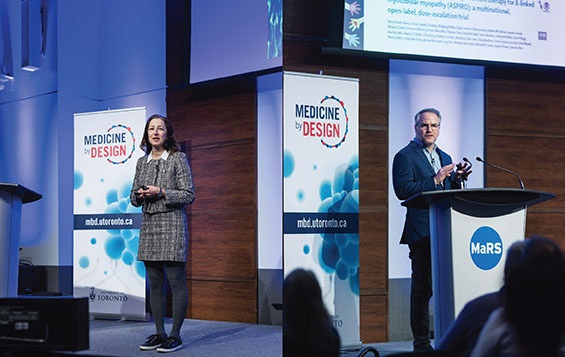
Molly Shoichet’s (left) talk focuses on how material transfer from injected photoreceptors can be used to deliver therapeutically relevant cargo to restore vision. James Dowling (right) spoke about cutting-edge gene therapies to treat rare diseases in children, focusing on The Hospital for Sick Children’s work on treating spastic paraplegia type 50 in a patient. The gene therapy has been well-tolerated and led to significant improvements. A larger clinical trial has received FDA approval.
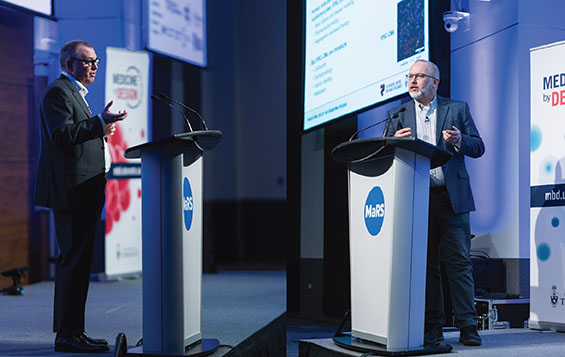
Both Michael Laflamme (left) and Craig Simmons (right) focused on the unmet need for mature human heart cells in therapies, which can improve clinical outcomes. Laflamme focused on his lab’s methods in this area with a stem cell biology perspective, and Simmons approached this topic with a mechanobiology and bioengineering perspective.

Sarah Crome (left) spoke about her lab’s work with immune cells, called ILC2s, and how they can be therapeutically applied. Omar F. Khan’s (right) presentation focused on his lab’s application of supramolecular chemistry to make more efficient RNA-based regenerative medicine therapies.
All photos by Neil Ta



